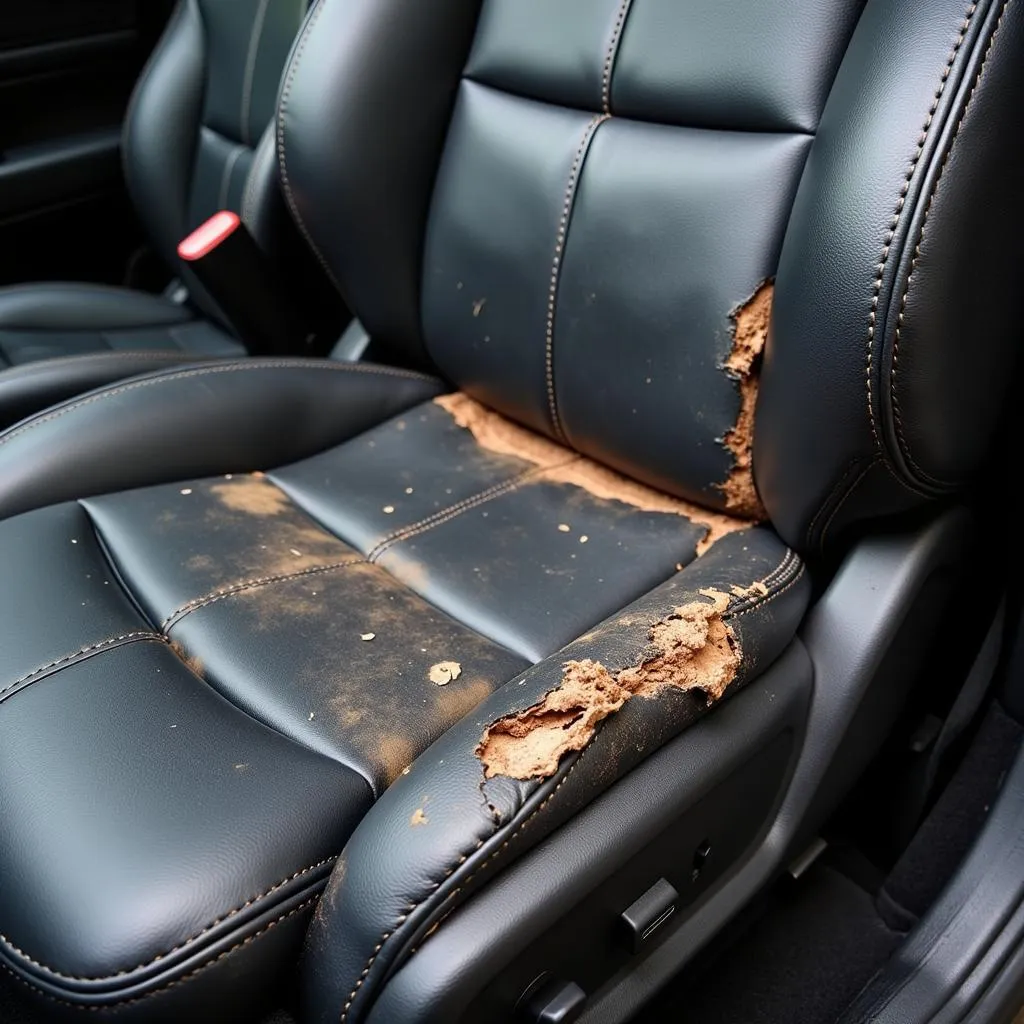Car seats endure a lot of wear and tear. From spills and crumbs to scratches and tears, it’s no surprise that they often require repairs. Whether you’re dealing with a minor cosmetic issue or a more serious structural problem, this guide will provide you with all the information you need to know about auto car seat repair.
Understanding Common Car Seat Problems
Before diving into repair options, it’s important to identify the specific issues you’re facing. Common car seat problems include:
- Tears, rips, and holes: These can occur due to sharp objects, rough use, or simply wear and tear over time.
- Burns: Cigarettes, lighters, and even hot beverages can leave unsightly burn marks on car seats.
- Stains: Food and drink spills, ink, and dirt can all cause stubborn stains on upholstery.
- Cracks and fading: Exposure to sunlight and heat can cause leather and vinyl seats to crack and fade.
- Sagging and worn-out padding: Years of use can take a toll on seat padding, leading to discomfort and an unappealing appearance.
- Broken or malfunctioning mechanisms: Reclining levers, seat adjusters, and power seat components can break or wear out over time.
DIY vs. Professional Auto Car Seat Repair
When it comes to car seat repair, you have two primary options: do it yourself (DIY) or hire a professional. The best approach depends on the severity of the damage, your budget, and your level of comfort with DIY projects.
DIY Car Seat Repair:
DIY repairs are generally suitable for minor cosmetic issues, such as small tears, burns, or stains. Numerous repair kits and products are available online and at auto parts stores. These kits often include patches, adhesives, cleaning solutions, and color-matching tools.
Advantages of DIY Repair:
- Cost-effective: DIY repairs are significantly cheaper than professional services.
- Convenient: You can work on your own schedule and avoid the hassle of taking your car to a shop.
- Sense of accomplishment: Successfully repairing your car seat can be rewarding.
Disadvantages of DIY Repair:
- Limited results: DIY solutions might not be effective for severe damage or complex repairs.
- Potential for further damage: Improper techniques or materials can worsen the existing damage.
- Time-consuming: DIY repairs can be time-consuming, especially for first-timers.
Professional Auto Car Seat Repair:
For significant damage, complex repairs, or if you’re not comfortable with DIY methods, professional repair is the recommended option. Experienced technicians have the skills, tools, and materials to handle a wide range of car seat issues.
Advantages of Professional Repair:
- High-quality results: Professionals can achieve seamless repairs that restore the look and feel of your car seats.
- Durability: Professional repairs are typically more durable and long-lasting than DIY solutions.
- Warranty: Many reputable shops offer warranties on their repair services.
Disadvantages of Professional Repair:
- Higher cost: Professional repairs are more expensive than DIY options.
- Time commitment: You’ll need to schedule an appointment and be without your car for a period of time.
Choosing the Right Auto Car Seat Repair Solution
The optimal repair solution depends on the specific problem you’re facing:
Tears, Rips, and Holes:
- Small tears and rips: Repair patches, leather filler, or vinyl repair kits can be effective for minor damage.
- Large tears or holes: Professional repair is generally recommended for larger tears or holes, as they often require patching, stitching, and upholstery work.
How do u repair a hole in car seat?
Burns:
- Minor burns: Leather or vinyl repair kits often include solutions for treating minor burns.
- Severe burns: Deep burns might require professional patching or replacement of the affected area.
How to repair burn mark in car seat
Stains:
- Common stains: Upholstery cleaners, stain removers, and home remedies (e.g., baking soda paste) can tackle most stains.
- Stubborn stains: Professional detailing services often include specialized stain removal techniques.
Cracks and Fading:
- Prevention is key: Use sunshades and conditioners to protect your seats from UV damage.
- Minor cracks and fading: Leather or vinyl repair kits can help restore the appearance.
- Severe damage: Professional reupholstery might be necessary for severely cracked or faded seats.
Sagging and Worn-Out Padding:
- Seat cushion replacement: You can purchase replacement cushions online or at auto parts stores.
- Professional reupholstery: For a complete restoration, consider professional reupholstery, which involves replacing the padding, fabric, and other components.
Broken or Malfunctioning Mechanisms:
- Minor repairs: If you’re mechanically inclined, you might be able to fix minor issues yourself with the help of online tutorials.
- Complex repairs: For complex mechanisms or electrical problems, professional repair is highly recommended.
How to repair car seat recliner
Tips for Preventing Car Seat Damage
Prevention is always better than cure. Here are some tips to keep your car seats in pristine condition:
- Use seat covers: Seat covers provide an extra layer of protection against spills, dirt, and wear and tear.
- Clean regularly: Vacuum and clean your car seats regularly to prevent dirt and grime from building up.
- Address spills immediately: Blot spills promptly to prevent them from setting into the upholstery.
- Avoid eating or drinking in your car: This minimizes the risk of spills and stains.
- Park in the shade: Protect your car seats from the sun’s harmful UV rays by parking in the shade whenever possible.
- Use a car seat protector: If you frequently transport children or pets, use a car seat protector to safeguard against spills, scratches, and fur.
Conclusion
Maintaining your car seats is crucial for preserving the comfort, appearance, and value of your vehicle. By understanding common car seat problems and repair options, you can make informed decisions about keeping your car’s interior looking its best. Whether you opt for DIY solutions or seek professional assistance, addressing issues promptly can save you time, money, and frustration in the long run. Remember, regular cleaning and preventative measures are essential for prolonging the life of your car seats.
FAQs
Q: Can I repair a cigarette burn in my car seat myself?
A: Yes, you can attempt to repair minor cigarette burns using DIY kits designed for leather or vinyl repair. However, deep burns might require professional attention.
How to repair cigarette burns in leather car seats
Q: How much does it cost to reupholster car seats?
A: The cost of car seat reupholstery varies depending on factors such as the type of material, the complexity of the job, and your location. On average, you can expect to pay several hundred dollars per seat.
Q: Can I use household cleaners on my car seats?
A: It’s generally not recommended to use harsh household cleaners on car seats, as they can damage delicate upholstery. Opt for specialized car upholstery cleaners or gentle cleaning solutions.
Q: How often should I clean my car seats?
A: It’s a good practice to vacuum your car seats weekly and perform a more thorough cleaning monthly or as needed.
Q: Can I replace just the seat cover, or do I need to replace the entire seat?
A: In some cases, you can replace just the seat cover. However, if the damage extends to the padding or other components, replacing the entire seat might be necessary.
Need help with your car seat repair? Contact us via WhatsApp: +1(641)206-8880 or Email: [email protected] for 24/7 support from our expert team.



